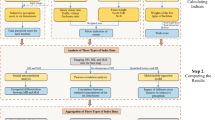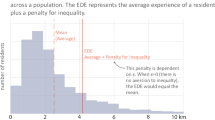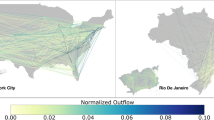Abstract
Cities are at the forefront of addressing global sustainability challenges, particularly those exacerbated by climate change. Traditional zoning codes, which often segregate land uses, have been linked to increased vehicular dependence, urban sprawl and social disconnection, undermining broader social and environmental sustainability objectives. This study investigates the adoption and impact of form-based codes (FBCs), which aim to promote sustainable, compact and mixed-use urban forms as a solution to these issues. Using natural language processing techniques, we analyzed zoning documents from over 2,000 United States census-designated places to identify linguistic patterns indicative of FBC principles. Our findings reveal widespread adoption of FBCs across the country, with notable variations within regions. FBCs are associated with higher floor to area ratios, narrower and more consistent street setbacks and smaller plots. We also find that places with FBCs have improved walkability, shorter commutes and a higher share of multifamily housing. Our findings highlight the utility of natural language processing for evaluating zoning codes and underscore the potential benefits of form-based zoning reforms for enhancing urban sustainability.
This is a preview of subscription content, access via your institution
Access options
Subscribe to this journal
Receive 12 digital issues and online access to articles
$119.00 per year
only $9.92 per issue
Buy this article
- Purchase on SpringerLink
- Instant access to full article PDF
Prices may be subject to local taxes which are calculated during checkout





Similar content being viewed by others
Data availability
We have provided information on all publicly available data used in our analysis in the Methods. The parcel data from Regrid by LOVELAND Technologies are confidential and cannot be shared publicly.
Code availability
The code to replicate the results in the paper is available via GitHub at https://github.com/ariannasm/Zoning.
References
Acevedo-De-los Ríos, A. Building Materials and the Climate: Constructing a New Future (UNEP, 2023).
Vallance, S., Perkins, H. C. & Dixon, J. E. Compact Cities: Everyday Life, Governance and the Built Environment An Annotated Bibliography and Literature Review (University of Auckland, 2009).
Talen, E. & Koschinsky, J. Compact, walkable, diverse neighborhoods: assessing effects on residents. Hous. Policy Debate 24, 717–750 (2014).
Sharifi, A. From Garden City to Eco-urbanism: the quest for sustainable neighborhood development. Sustain. Cities Soc. 20, 1–16 (2016).
Duranton, G. & Puga, D. The economics of urban density. J. Econ. Perspect. 34, 3–26 (2020).
Feitelson, E. The spatial effects of land use regulations a missing link in growth control evaluations. J. Am. Plan. Assoc. 59, 461–472 (1993).
Shen, Q. Spatial impacts of locally enacted growth controls: the San Francisco Bay region in the 1980s. Environ. Plan. B 23, 61–91 (1996).
Talen, E. Zoning for and against sprawl: the case for form-based codes. J. Urban Des. 18, 175–200 (2013).
Hsieh, C.-T. & Moretti, E. Housing constraints and spatial misallocation. Am. Econ. J. 11, 1–39 (2019).
Pendall, R. Local land use regulation and the chain of exclusion. J. Am. Plan. Assoc. 66, 125–142 (2000).
Levine, J. Zoned out: Regulation, Markets, and Choices in Transportation and Metropolitan Land Use (RFF Press, 2005).
Knaap, G.-J., Haccoû, H. A., Clifton, K. J. & Frece, J. W. (eds) Incentives, Regulations and Plans (Edward Elgar, 2007).
Monkkonen, P., Manville, M. & Lens, M. It’s time to end single-family zoning. J. Am. Plan. Assoc. 86, 106–112 (2020).
Whittemore, A. H. Exclusionary zoning. J. Am. Plan. Assoc. 87, 167–180 (2021).
Manville, M., Lens, M. & Monkkonen, P. Zoning and affordability: a reply to Rodríguez-Pose and Storper. Urban Stud. 59, 36–58 (2022).
Shertzer, A., Twinam, T. & Walsh, R. P. Zoning and segregation in urban economic history. Reg. Sci. Urban Econ. 94, 103652 (2022).
Garde, A. & Song, Q. Housing affordability crisis and inequities of land use change. J. Am. Plan. Assoc. 88, 67–82 (2022).
Talen, E. & Knaap, G. Legalizing smart growth: an empirical study of land use regulation in Illinois. J. Plan. Educ. Res. 22, 345–359 (2003).
Soule, D. S. (ed) Urban Sprawl: A Comprehensive Reference Guide (Greenwood, 2006).
Tyagi, E. & MacDonald, G. We Need Better Zoning Data. Data Science Can Help (Urban Institute, 2019).
Shanks, B. Land Use Regulations and Housing Development—Evidence from Tax Parcels and Zoning Bylaws in Massachusetts (2021).
Song, J. The effects of residential zoning in U.S. housing markets. SSRN https://doi.org/10.2139/ssrn.3996483 (2024).
Gyourko, J., Saiz, A. & Summers, A. A new measure of the local regulatory environment for housing markets: the Wharton residential land use regulatory index. Urban Stud. 45, 693–729 (2008).
Mleczko, M. & Desmond, M. Using natural language processing to construct a national zoning and land use database. Urban Stud. 60, 2564–2584 (2023).
Ghorbanian, M. The evolution of urban zoning from conventional to form based codes; introducing non-Euclidean zoning techniques. Int. J. Architect. Eng. Urban Plan 30, 107–118 (2020).
Gray, M. N. Arbitrary Lines: How Zoning Broke the American City and How to Fix It (Island Press, 2022).
Staveski, A. & Horowitz, A., Liang, L. Minneapolis Land Use Reforms Offer a Blueprint for Housing Affordability (Pew Charitable Trust, 2024).
Jacobs, J. The Death and Life of Great American Cities (Random House, 1961).
Talen, E. City Rules: How Regulations Affect Urban Form (Island Press, 2012).
Garde, A. & Kim, C. Form-based codes for zoning reform to promote sustainable development: insights from cities in southern California. J. Am. Plan. Assoc. 83, 346–364 (2017).
Hansen, G. Design for healthy communities: the potential of form-based codes to create walkable urban streets. J. Urban Des. 19, 151–170 (2014).
Chin, J. T. Coding for predictive built environments: building and street typology choices in form-based codes. J. Asian Archit. Build. Eng. 23, 355–371 (2024).
Hughen, W. K. & Read, D. C. Analyzing form-based zoning’s potential to stimulate mixed-use development in different economic environments. Land Use Policy 61, 1–11 (2017).
Garde, A. & Hoff, A. Zoning reform for advancing sustainability: insights from Denver’s form-based code. J. Urban Des. 22, 845–865 (2017).
Zhang, Y. Evaluating parametric form-based code for sustainable development of urban communities and neighborhoods. Int. J. Environ. Res. Public Health 19, 7389 (2022).
Garfinkel-Castro, A., Hassan Ameli, S., Hamidi, S. & Ewing, R. Do better urban design qualities lead to more walking in Salt Lake City, Utah? J. Urban Des. 20, 393–410 (2015).
Sung, H., Go, D., Choi, C.-G., Cheon, S. & Park, S. Effects of street-level physical environment and zoning on walking activity in Seoul, Korea. Land Use Policy 49, 152–160 (2015).
Buttazzoni, A. & Minaker, L. Exploring the relationships between specific urban design features and adolescent mental health: The case of imageability, enclosure, human scale, transparency, and complexity. Landsc. Urban Plan. 235, 104736 (2023).
Market Acceptance of Smart Growth (EPA, 2011).
Talen, E. The socio-economic context of form-based codes. Landsc. Urban Plan. 214, 104182 (2021).
Park, Y. Does new urbanist neighborhood design affect neighborhood turnover? Land Use Policy 68, 552–562 (2017).
Tagtachian, D., Barefoot, N. & Harreveld, A. Building by right: social equity implications of transitioning to form-based code. J. Affordable Housing Commun. Dev. Law 71 (2019).
Denoon-Stevens, S. P. & Nel, V. Towards an understanding of proactive upzoning globally and in South Africa. Land Use Policy 97, 104708 (2020).
Özay, E. Code as urban vision: a critique of the Buffalo Green Code. J. Urban Des. 27, 364–385 (2022).
Talen, E. Matthew Lambert Hazel Borys. Code Score (2019).
Bronin, S. C. Zoning by a thousand cuts. Pepperdine Law Rev. 50, 719–784 (2023).
Sahn, A. Racial Diversity and Exclusionary Zoning: Evidence from the Great Migration (Berkley, 2021).
Perez, T. Top 10 Misconceptions about Form-Based Codes (CNU, 2016).
Satterthwaite, D. Successful, safe and sustainable cities: towards a new urban agenda. Commonw. J. Local Gov. 19, 3–18 (2016).
Silva, C. N. & Trono, A. (eds) Local Governance in the New Urban Agenda (Springer, 2020).
Leyk, S. & Uhl, J. H. HISDAC-US, historical settlement data compilation for the conterminous United States over 200 years. Scientific Data 5, 180175 (2018).
Microsoft. USBuildingFootprints: computer-generated building footprints for the United States. GitHub https://github.com/microsoft/USBuildingFootprints (2018).
Boeing, G. Modeling and Analyzing Urban Networks and Amenities with OSMnx (OSMnx, 2024).
Acknowledgments
We are grateful to A. Saiz for helpful early discussions on the topic and to the Mansueto Institute for Urban Innovation at the University of Chicago for their support.
Author information
Authors and Affiliations
Contributions
A.S-M. designed research and performed data analysis. A.S-M. and E.T wrote the paper.
Corresponding author
Ethics declarations
Competing interests
The authors declare no competing interests.
Peer review
Peer review information
Nature Cities thanks Manuel Bickel and Catherine Brinkley for their contribution to the peer review of this work.
Additional information
Publisher’s note Springer Nature remains neutral with regard to jurisdictional claims in published maps and institutional affiliations.
Supplementary information
Supplementary Information
Fig. 1 and Tables 1–5
Rights and permissions
Springer Nature or its licensor (e.g. a society or other partner) holds exclusive rights to this article under a publishing agreement with the author(s) or other rightsholder(s); author self-archiving of the accepted manuscript version of this article is solely governed by the terms of such publishing agreement and applicable law.
About this article
Cite this article
Salazar-Miranda, A., Talen, E. An AI-based analysis of zoning reforms in US cities. Nat Cities 2, 304–315 (2025). https://doi.org/10.1038/s44284-025-00214-0
Received:
Accepted:
Published:
Issue date:
DOI: https://doi.org/10.1038/s44284-025-00214-0
This article is cited by
-
An AI analysis of zoning reforms
Nature Cities (2025)



